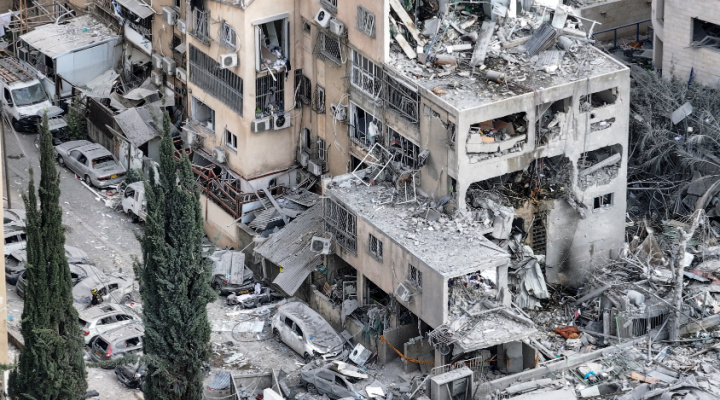A drone photo shows the damage over residential homes and a school at the impact site following a missile attack from Iran on Israel, in Bnei Brak, Israel, June 16, 2025. Photo: REUTERS/Chen Kalifa
In the 1970s, I arrived in Israel as an exchange student from Berkeley. The country was still reeling from the Yom Kippur War — having narrowly escaped annihilation. Confidence was shattered, every household had felt loss, and the optimism of 1967 felt like a distant memory.
What struck me at the time was how so many Israelis in the prime of life were desperate for any visa — especially to the US — as a way to escape runaway inflation and collective despair.
Today, circumstances couldn’t be more different. Despite being under siege by ballistic missiles, hundreds of thousands of Israelis –abroad for holidays, studies, or business — are now desperately trying to return. Observers have noted that this is the only country at war where people are racing to come home.
Those who are able to return are being greeted by a reality like my own experience last Sunday night — when a missile landed just a hundred yards from my front door.
I was below ground in a reinforced concrete bomb shelter, but its steel doors rattled like a tin can during impact. When I emerged in the pre-dawn light, my familiar neighborhood near Tel Aviv’s Carmel Market was unrecognizable: glass littered the streets, debris was piled around shattered homes, and storefronts were heavily damaged. In my sandals, I helped elderly neighbors walk back to their flats, treading as carefully as possible through the glittering shards.
Adrenaline kept me going, but as daylight fell and I absorbed the scale of destruction, the weight of the night hit home. My daughter, in New York, called in tears. “The airport is closed — how will you get out of there?” she sobbed. I responded firmly: “Should 7 million Jews pack up and go? I could do that, but you’ll have to say goodbye to your future.”
These past few days have been an exhausting blur of sirens, shelter drills, and rehearsed routines. Our neighborhood — laced with 1930s Bauhaus structures — was never built for war. After October 7, rocket barrages from Gaza became the norm. But now the threat has escalated far beyond that.
When the sirens sound, my wife and I have only 60 to 90 seconds: shoes on, phones in hand, down three flights of stairs, into the street, and into a nearby public shelter. Even in deep sleep, muscle memory guides us to safety without thought. What once felt almost routine — trusting the Iron Dome to intercept rockets — now seems fragile in comparison.
The reason is stark: Iran’s Fattah‑1 hypersonic ballistic missiles are changing the game.
Traveling at speeds up to Mach 13–15, equipped with maneuverable gliding warheads, they often evade interception systems. Launched hundreds of times, they are specifically targeted at civilian centers. While Israel’s multi-layered defenses — Iron Dome, David’s Sling, Arrow — still intercepts most missiles, those that get through inflict serious damage, sometimes even striking designated safe rooms.
Fortunately, because these missiles come from long range, our phones buzz early — giving us those precious extra seconds to reach shelter before the local sirens blare.
Inside the shelter, an unexpected sense of community emerges. Elderly neighbors shuffle in anxiously, attempting to navigate steps under duress. Meanwhile, children born shortly before and after October 7 — some mere toddlers when conflict erupted — play confidently, chattering with each other, hugging dogs, and passing toys. Their eyes show not terror but determination and spirit. These are the children of Israel: enduring, brave, noble.
I’ve witnessed Israel’s journey — from the despair of the 1970s through its revival, and now this current test. We are standing under a barrage of missiles, yet refusing to sacrifice either our values or our indigenous homeland to hate-driven terror.
There is no question that these hypersonic missiles fundamentally alter our security assumptions. They undermine systems designed for slower threats, strain the resilience of shelter infrastructure built to older standards, and force us to rehearse survival in a way we never imagined. Yet even as threats evolve, so do we — fastening shoes, teaching children to run, organizing neighbors, maintaining routine in the ruins. We show up, day after day.
In this shelter — not by accident, but by conviction — we are proclaiming to the world: we are here. We are unbowed. We will stay.
Dr. Ron Katz is President of the Tel Aviv Institute. He can be reached at tlvi.org
The post The View From an Israeli Bomb Shelter: 60 Seconds to Survival first appeared on Algemeiner.com.
Click this link for the original source of this article.
Author: Ron Katz
This content is courtesy of, and owned and copyrighted by, https://www.algemeiner.com and its author. This content is made available by use of the public RSS feed offered by the host site and is used for educational purposes only. If you are the author or represent the host site and would like this content removed now and in the future, please contact USSANews.com using the email address in the Contact page found in the website menu.








